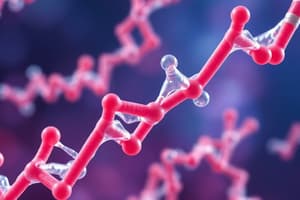Podcast
Questions and Answers
What characteristic of enzymes allows them to be used multiple times in cellular reactions?
What characteristic of enzymes allows them to be used multiple times in cellular reactions?
- They form covalent bonds with substrates.
- They alter their structure after each reaction.
- They require constant regeneration by cells.
- They are not chemically changed by the reaction. (correct)
Which of the following enzyme names correctly reflects the substrate it acts upon?
Which of the following enzyme names correctly reflects the substrate it acts upon?
- Lipase, which synthesizes lipids
- Phosphatase, which synthesizes phosphates
- Amylase, which digests nucleic acids
- Protease, which digests proteins (correct)
What representation depicts an enzyme facilitating a digestion reaction?
What representation depicts an enzyme facilitating a digestion reaction?
- An enzyme converting orange products back to yellow substrates.
- An enzyme combining green substrates into a dark green product.
- An enzyme breaking down a yellow substrate into orange products. (correct)
- An enzyme synthesizing a gray product from colored substrates.
Why is it important for cells to maintain a specific concentration of enzymes?
Why is it important for cells to maintain a specific concentration of enzymes?
Which of the following statements about enzyme activity is incorrect?
Which of the following statements about enzyme activity is incorrect?
What is the primary function of enzymes in biochemical reactions?
What is the primary function of enzymes in biochemical reactions?
Which statement correctly describes the structural characteristic necessary for enzyme functionality?
Which statement correctly describes the structural characteristic necessary for enzyme functionality?
What part of an enzyme directly interacts with substrates during a reaction?
What part of an enzyme directly interacts with substrates during a reaction?
Which of the following statements about enzymes is false?
Which of the following statements about enzymes is false?
What role do enzymes play in metabolism?
What role do enzymes play in metabolism?
What characteristics must a substrate possess to interact successfully with an enzyme's active site?
What characteristics must a substrate possess to interact successfully with an enzyme's active site?
Why might an enzyme fail to bind with a specific substrate?
Why might an enzyme fail to bind with a specific substrate?
What feature of the enzyme's active site contributes to its specificity for different substrates?
What feature of the enzyme's active site contributes to its specificity for different substrates?
What occurs during the interaction between an enzyme and a substrate at the active site?
What occurs during the interaction between an enzyme and a substrate at the active site?
Which statement regarding the nature of substrates interacting with enzymes is false?
Which statement regarding the nature of substrates interacting with enzymes is false?
Flashcards are hidden until you start studying
Study Notes
Enzymes as Biological Catalysts
- Enzymes accelerate biochemical reactions, functioning as biological catalysts.
- Most enzymes are proteins with a specific tertiary structure essential for their activity.
- Each enzyme contains an active site, a region designed to bind substrates.
Active Site and Substrate Interaction
- Substrates are molecules that interact with enzymes to undergo chemical transformations.
- The active site features a unique shape and size tailored to fit specific substrates.
- Compatibility of physical and chemical properties between the enzyme and substrate is crucial for binding.
- Minor conformational changes in the enzyme may occur upon substrate binding, optimizing the fit.
Enzyme Naming and Characteristics
- Enzymes often include references to their substrates or reactions in their names, typically ending in "-ase."
- Example: Sucrase is an enzyme specifically designed to digest sucrose.
- Enzymes are reusable; they remain chemically unchanged after reactions, allowing them to act on multiple substrate molecules.
- Cells regulate enzyme concentrations to maintain optimal conditions for biochemical processes.
- Enzymes can catalyze both synthesis (combining substrates) and digestion (breaking down substrates) reactions.
Visual Representations of Enzyme Activity
- Hydrolysis: Diagram depicts an enzyme reducing a substrate into products, with the substrate shown in yellow and products in orange.
- Synthesis: Diagram illustrates an enzyme joining substrates to produce a single product, with substrates in green and the product in dark green.
Studying That Suits You
Use AI to generate personalized quizzes and flashcards to suit your learning preferences.





